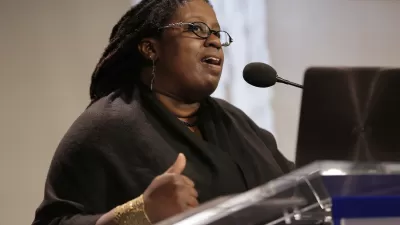Courtney Knapp of the Pratt Institute writes about a recent article in the Journal of Planning Education and Research

Planning students and practitioners need tools and strategies to build critical self-awareness, foster communication and radical empathy across difference, and facilitate emotionally and politically sensitive and constructive discussions in communities. This need is acute within our profession, considering planners’ historic contributions toward reproducing place-based racial inequalities and exclusions. My study, "Integrating Critical Autobiography to Foster Anti-Racism Learning in the Urban Studies Classroom," recently published in the Journal for Planning Education and Research, examines one potential tool for engaging in this reflexive, sometimes painful work: critical autobiographical writing.
The study uses a longitudinal, mixed method approach to ask and answer the following question: can structured autobiographical writing help individuals (in the case of this study, undergraduate students) cultivate critical awareness in ways that encourage them to locate their own experiences within patterns and structures of inclusion/exclusion, and in ways that inspire longer-term commitments to anti-racism and social justice praxis? To answer this question, I combine a critical interpretation of a sample of students’ essays with the results of a post-course survey and interviews, designed to assess potential longer-term impacts of the assignment.
My analysis revealed a number of trends relevant to planners and planning educators. First, despite students’ highly diverse cultural, socioeconomic, and geographic backgrounds, their stories of personal racial identity formation shared common narrative arcs. Regardless of race, most followed a similar format of naivety—encounter—cognitive dissonance—epiphany. Surveyed several years later, some students reported that sharing their testimonies in class had allowed then to find common ground with their peers and form lasting bonds.
Second, the study revealed that students used thirty distinct identity markers to describe their personal racial identities. Related, students identified more than eighty social, and a dozen geographic, factors influencing their personal identity formation and understandings of race and racism. These perspectives suggest individuals’ identities are more complex and multi-faceted than standard public discourse and demography afford. Supplementing community-level race and ethnicity data with autobiographical testimony can help bring census data to life.
Third, students’ essays and follow-up responses underscored the significance of interpersonal encounters in shaping these understandings. This was especially true for students’ families, close friends, classmates, and teachers. Related, daily environments, especially school settings, where highly influential. The assignment had prompted students to connect to their personal stories with theoretical and discussions of race and place. Students who connected their personal experiences with established conceptual frameworks (for example, Jewish anti-racist scholar George Lipsitz), reported higher levels of sustained engagement with social justice issues following the class. Importantly, many students reported the assignment had helped them build self-confidence to discuss emotionally and politically charged topics, such as local legacies of racism.
So what are the takeaways for planning education and practice? Certainly, planning schools are where professionals-in-training have historically grappled with these sorts of questions, and the academy will no doubt continue to play critical roles convening spaces to discuss race, place, and planning in structured and substantive ways. However, critical autobiography writing is also useful outside the classroom, where it can be incorporated into strategic planning and community engagement processes on the local, neighborhood, or organizational levels.
Autobiography writing allowed participants to go beyond standard identity markers of race and cultural belonging, and explore how personal experiences, environments, and social influences shaped them as unique individuals. During a follow up interview, one student summarized this lesson succinctly, stating that the exercise reminded her that even though she was “training to be a planner, I am a person with a story, and I have an obligation to listen to the stories of the people I work with and serve. Planning is about trying to understand the complexity of identity in place, which goes way deeper than the standard checkbox definitions of race” (quoted in Knapp 2018, p. 10).
In short, behind every checked box on a census or community engagement form is a person, an individual with a complex racial identity and story of be/longing. To the extent planners can tap into these emotional and value-based attachments, and leverage them to strengthen social bonds and foster common ground across diverse populations, the better off our profession, and by association, the communities we serve, will be.
Full Article Open Access Until March 28, 2019
Courtney Knapp Ph.D. AICP., is an Associate Professor of City and Regional Planning at Pratt Institute. She is the author of Constructing the Dynamo of Dixie: Race, Urban Planning, and Cosmopolitanism in Chattanooga, Tennessee(2018, UNC Press).

Trump Administration Could Effectively End Housing Voucher Program
Federal officials are eyeing major cuts to the Section 8 program that helps millions of low-income households pay rent.

Planetizen Federal Action Tracker
A weekly monitor of how Trump’s orders and actions are impacting planners and planning in America.

Ken Jennings Launches Transit Web Series
The Jeopardy champ wants you to ride public transit.

Rebuilding Smarter: How LA County Is Guiding Fire-Ravaged Communities Toward Resilience
Los Angeles County is leading a coordinated effort to help fire-impacted communities rebuild with resilience by providing recovery resources, promoting fire-wise design, and aligning reconstruction with broader sustainability and climate goals.

When Borders Blur: Regional Collaboration in Action
As regional challenges outgrow city boundaries, “When Borders Blur” explores how cross-jurisdictional collaboration can drive smarter, more resilient urban planning, sharing real-world lessons from thriving partnerships across North America.

Philadelphia Is Expanding its Network of Roundabouts
Roundabouts are widely shown to decrease traffic speed, reduce congestion, and improve efficiency.
Urban Design for Planners 1: Software Tools
This six-course series explores essential urban design concepts using open source software and equips planners with the tools they need to participate fully in the urban design process.
Planning for Universal Design
Learn the tools for implementing Universal Design in planning regulations.
Ada County Highway District
Clanton & Associates, Inc.
Jessamine County Fiscal Court
Institute for Housing and Urban Development Studies (IHS)
City of Grandview
Harvard GSD Executive Education
Toledo-Lucas County Plan Commissions
Salt Lake City
NYU Wagner Graduate School of Public Service






























